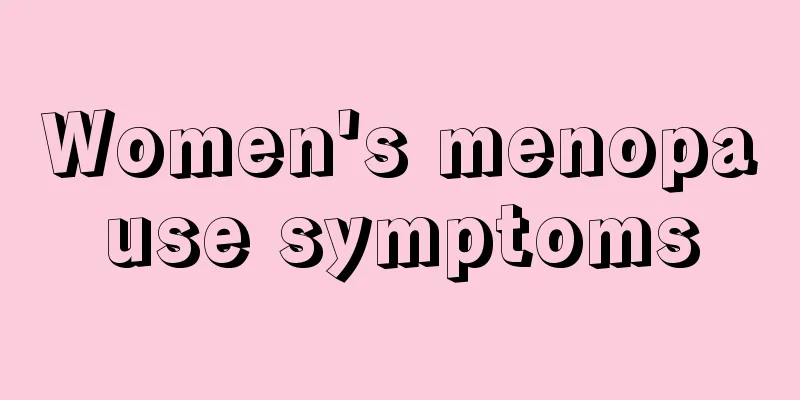How many days can I squeeze out the milk after weaning?

|
During the weaning period, many women will have the problem of breast engorgement. Of course, when the milk is swollen, you can deal with it through certain methods. For example, if the milk is swollen very much, you can squeeze out a moderate amount. However, when milking, you must not overdo it, because excessive milking will have a certain impact on breast health and may very likely lead to diseases such as mastitis! 1. Can I squeeze the milk when I am weaning? When the milk is swelling rapidly after weaning, you can squeeze it out a little. But you must not squeeze it out, you must be moderate. The traditional practice is that even if the milk is increasing, you cannot squeeze it. The old people will say that if the milk increases a little, it will go back down. But in fact, allowing the breasts to swell without limit is very risky. Once the milk ducts are blocked, it is very likely to cause mastitis. Therefore, in order to prevent mastitis caused by weaning, it is still necessary to slowly express milk when breasts are full. If the swelling is unbearable, apply a hot towel to your breasts to relieve the pain. When the pain becomes unbearable, touch the lump in your breast with your hand. If it feels hard and you can even see the bulge in the milk duct, you can squeeze out some milk. But don't squeeze too much, and do it step by step, squeezing less each time. 2. How long will it take for milk to increase after weaning? Studies have found that the production of milk is the result of the combined action of prolactin and the lactation reflex. The baby's sucking stimulates the nerve endings of the nipple and transmits the stimulation information to the anterior pituitary gland, causing it to secrete prolactin. During the weaning process, the baby's sucking time and frequency will decrease, and the secretion of prolactin will also decrease accordingly. The milk secretion will slowly change from large amount to cessation, and the milk engorgement will gradually disappear. This is a natural process. Mothers who are weaning do not need to be too nervous. Generally, the milk will stop flowing on its own within a week to half a month and the milk will not swell again. During normal weaning, if there is too much milk and natural weaning is not effective, artificial weaning methods can also be used. 3. Precautions during weaning When weaning, mothers need to pay attention and prevent mastitis. The key to weaning is to reduce stimulation to the breast nipples. In addition to reducing sucking, avoid letting the baby touch the breast; appropriately control the amount of water intake in the diet; when the breasts are swollen and uncomfortable, you can squeeze out a small amount of milk, but you should not over-squeeze to avoid stimulation and excessive milk secretion; you can also use ice packs to cool the breasts to reduce discomfort; in addition, you can also use some medications to stop milk production under the guidance of a doctor. |
<<: Breast engorgement but can't express milk
>>: What should I do if I don't plan to breastfeed?
Recommend
Premenstrual depression
Menstruation is a physiological phenomenon unique...
How to treat posterior uterine wall adenomyosis
Posterior uterine wall adenomyosis is a disease t...
Can I eat soybean paste during breastfeeding?
When women are breastfeeding, they must pay atten...
My underwear is always wet and smells bad
My underwear is always wet and smells bad For wom...
Breast enlargement and pain
Have you had sexual intercourse recently? If you ...
Chinese medicine for vaginitis
Vaginitis is a common gynecological disease in wo...
Can pregnant women eat red dates? Are there any taboos?
Pregnant women should pay attention to dietary co...
Hot search! The potassium content is nearly 3 times that of bananas. This melon promotes bowel movements and is very low in calories. I really recommend you try it!
The TV series "People in the Alley" has...
[Emergency Science Popularization] This disease surges in the spring, people with weakened immune systems should be careful!
Shingles can be called the "most painful ski...
What causes rapeseed stalk rot? What medicine should be used to prevent and treat rapeseed stalk rot?
Rapeseed is a common vegetable in life. It is dee...
The soil of the newly bought flowers is very wet when they are repotted. Do I still need to water them? Why can't I keep the flowers I bought from the flower market alive?
Many people buy their first flower pot at the flo...
At the beginning of the school year, do parents understand their children's mental health?
The start of the school year is an important psyc...
A woman dreams of water in the house
It is a very important resource for many microorg...
What to do if the baby is small during pregnancy
During pregnancy, when the fetus is growing and d...
Can Bactroban be used to clean the genitals?
Bactroban is an external application cream with a...









